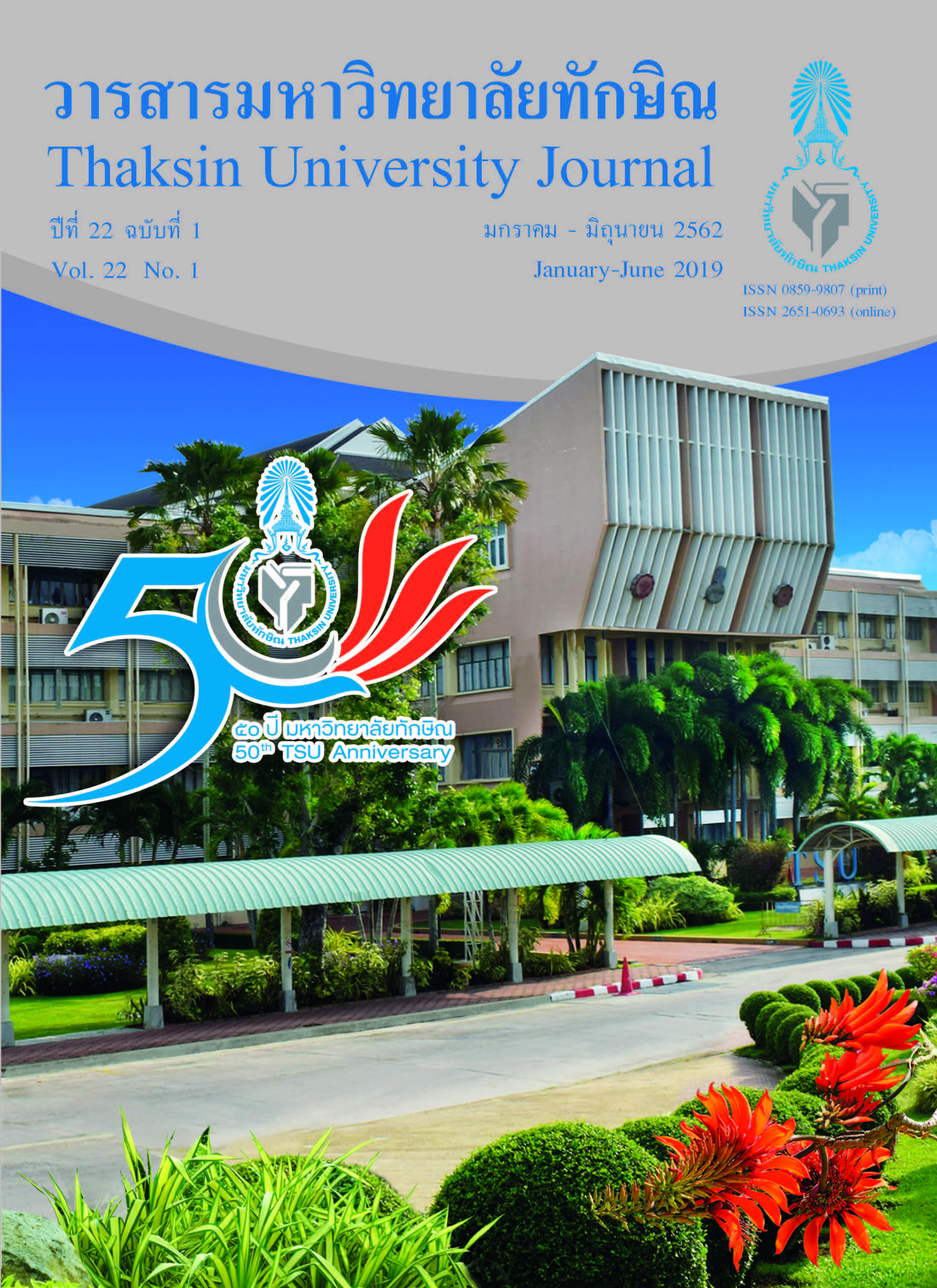Evaluation of Betel Leaf Extract Deodorizing Foot Spray
Main Article Content
Abstract
Foot odor is a problem that many people have to deal with on a daily basis. The present study was
designed to evaluate the ethanolic extract of betel leaves as an ingredient in deodorizing foot spray product, and the formulation was developed as a prototype spray. The deodorizing activity over foot malodor was studied by GC-MS technique and olfactory method. The formula of developed spray for foot malodor treatment consists of 0.1 % betel leaf extract, 30 % aluminium chlorohydrate solution, 5 % propylene glycol, 2 % glycerin, 0.1 % butylhydroxyl anisole and 1 % concentrated paraben in purified water by weight. This formula had a good appearance, fast-drying, non-greasy and thin coating on the skin surface after application. The product exhibited anti-bacterial activity against Staphylococcus epidermidis ATCC12228 and Bacillus subtilis ATCC6633 with diameters of inhibition zone of 14.77 ± 0.21 mm and 14.0 ± 0.35 mm, respectively.
Article Details

This work is licensed under a Creative Commons Attribution-NonCommercial-NoDerivatives 4.0 International License.
References
Oxford: Blackwell Science Ltd.
[2] Benohanian, A. (2001). Antiperspirants and Deodorants. Clinics in Dermatology, 19, 398-405.
[ 3] Dwivedi, V., & Tripathi, S. ( 2014) . Review Study on Potential Activity of Piper betle. Journal of
Pharmacognosy and Phytochemistry, 3, 93-98.
[4] Khan, J. A., & Kumar, N. (2011). Evaluation of Antibacterial Properties of Extracts of Piper betel Leaf.
Journal of Pharmaceutical and Biomedical Sciences, 11, 1-3.
[5] Ali, I., Khan, F. G., Suri, K. A., Gupta, B. D., Satti, N. K., Dut, T. P., Afrin, F., Qazi, G. N., & Khan, I. A.
(2010). In Vitro Antifungal Activity of Hydroxychavicol Isolated from Piper betle L. Annals of Clinical
Microbiology and Antimicrobials, 9, 7-15.
[6] Caburian, A. B., & Osi, M. O. (2010). Characterization and Evaluation of Antimicrobial Activity of the
Essential Oil from the Leaves of Piper betle L. E-International Scientific Research Journal, 2, 2-13.
[7] Nanayakkara, B. S., Abayasokara, C. L., & Panagoda, G. J. (2014). Anti-candidal Activity of Piper betle (L.),
Vitex negundo (L.) and Jasminum grandiflorum. African Journal of Microbiology Research, 8, 2307-2314.
[8] Natthaya, P. (2009). Development of Foot Spray Product using Essential Oil in Inhibitory Micrococcus
sedentarius Growth. Master's Thesis. Kasetsart University.
[9] Ara, K., Hama, M., Akiba, S., Koike, K., Okwasaka, K., Hagura, T., Kamiya, T., & Tomita, F. (2006). Foot Odor
Due to Microbial Metabolism and Its Control. Canadian Journal of Microbiology, 52, 357-364.
[10] Subashkumar, R., Sureshkumar, M., Babu, S., & Thayumanavan, T. (2013). Antibacterial Effect of Crude
Aqueous Extract of Piper betle L. Against Pathogenic Bacteria. International Journal of Research
in Pharmaceutical and Biomedical Sciences, 4, 42-46.
[11] Inam, F., Deo, S., & Narkhede, N. (2014). HPLC-UV Method Development and Quantification of Eugenol
from Methanolic Extracts of Some Spices. International Journal of Chemical and Physical Sciences,
3, 96-102.
[12] Caroprese, A., Gabbanini, S., Beltramini C., Lucchi, E., & Valgimigli, L. (2009). HS-SPME-GC-MS
Analysis of Body Odor to Test the Efficacy. Skin Research and Technology, 15, 503-510.
[13] Kim, K. H. , & Park, S. Y. ( 2008) . A Comparative Analysis of Malodor Samples between Direct
(Olfactometry) and Indirect (Instrumental) Methods. Atmospheric Environment, 42, 5061-5070.
[14] Martell, M. J., & Boothe, J. H. ( 1967) . The 6-deoxytetracyclines VII Alkylated Aminotetracyclines
Possessing Unique Antibacterial Activity. Journal of Medicinal and Pharmaceutical Chemistry,
10, 44-46.

